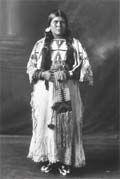|
|
Sitting along side Hangman Creek and near the Sweat House, listen as Lawrence Aripa tells of Coyote and the Rock Monster. In this oral tradition you will learn how much of the land was originally formed and how Lake Coeur d'Alene was given its unique color. Part 1 (originally developed as part of the 1993 Me-Y-Mi-Ym Project; recorded and edited by Dan Kane; project director Rodney Frey)
|
 | | Mary Agatha Antelope, ca. 1910 |
The Animal Peoples of the creation time come "alive" each time Lawrence or any other storyteller re-tells the accounts of Coyote, Salmon, Four Smokes, or the other Animal Peoples. Traditionally, the storytellers in the community have the special responsibility as caretakers of the oral traditions. While some oral traditions are family stories and are only told among relatives, the vast majority of the stories are widely shared throughout the community. Typically Coyote stories are only told during the winter months, often associated with the holding of the Jump Dances in January and February. While everyone has the potential to become an accomplished raconteur, only a few elders are acknowledged for their particular adeptness and are widely recognized for their storytelling abilities. Given the wide differences in the styles among storytellers, the varied techniques and styles used by storytellers, nevertheless, all coalesce and seek to transform the listeners of the story into participants within the story. Listeners "swirl around" and travel with the Coyote as he plays some trick on a "younger brother" or slays a "man-eater" threatening the other Animal Peoples. Listeners witness the creation time as if for the first time. As an oral tradition, the modes and means of its presentation thus directly contribute to the meaning conveyed within the stories, as well as to the role and significance the oral traditions play in the lives of the Schitsu’umsh.
|
|
Listen as Lawrence Aripa continues telling of Coyote and the Rock Monster. Part 2 |
As you listen with your heart, pay special attention to how Lawrence is telling the stories. What storytelling techniques is he using to draw you into the story?
© Coeur d'Alene Tribe 2002
< previous |
next >
|



